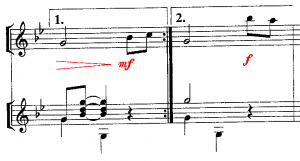Инструменты пользователя
Боковая панель
Содержание
The Dynamic Range
Hello, I am Nikita Kipriyanov from Voronezh, Russia. This will be a lesson about dynamic range - what is it, why is important to understand the concept of dynamics and how to manipulate it.
In short, the dynamics is variations in volume or loudness. The dynamic range is the distance between quietest and loudest sound; the exact definition always depends on application, since the same term is used in different contexts and has somewhat different meanings.
Hovewer, in every context we use logarithmic scale, and express it in decibelles. The scale is logarithmic, this means that decibell is relative unit. The exact («amplitude») definition of decibell is:
 where A and A0 is the absolute amplitude values, and A0 is the known base value. Adb is then A expressed in decibelles relative to A0.
where A and A0 is the absolute amplitude values, and A0 is the known base value. Adb is then A expressed in decibelles relative to A0.
A0 is different in each case. For SPL, this is the amplitude of the quietest sound which is possible to hear, so everything other is positive. In digital, this is the loudest representable sound, so everything other is negative.
The rule of thumb, easy to remember and use in digital audio, is the following: if the amplitude of X is twice amplitude of Y, then X is 6 dB louder than Y. (Actually it is 6.03417633655 dB louder.) The following table summarizes this relation between amplitude relations and decibelles:
| dB | times |
|---|---|
| 1 | 1.12 |
| 3 | 1.4 |
| 6 | 2 |
| 9.5 | 3 |
| 12 | 4 |
| 20 | 10 |
Musical Dynamics
 The concept of dynamics is well known in music. It means, how hard or how soft the performer will push his instrument. Usually the instrument will sound louder when pushed harder, but the percieved loudness changes is not only because the amplitude of sound changes, but also because the timbre changes.
The concept of dynamics is well known in music. It means, how hard or how soft the performer will push his instrument. Usually the instrument will sound louder when pushed harder, but the percieved loudness changes is not only because the amplitude of sound changes, but also because the timbre changes.
The dynamic range of an instrument is the distance betweet the quietest and loudest musical sound the intrument can play. Different instruments have different ranges.
| Source | Dynamic range |
|---|---|
| Symphonic orchestra | 60 dB and more |
| Grand piano | 45 dB |
| Voice | 40 dB |
| Cello | 35 dB |
| Bassoon | 30 dB |
| Guitar | 15 dB |
The part of a musical score on the right side shows dynamics notation adopted in the music. The dynamics notation is relative to instrument range. The quietest sound noted as «ppp» (pianissimo), the loudest as «fff» (fortissimo). The scale goes from ppp, through p (piano), mp, (mezzo-piano), mf, f (forte) to fff. These are not quite exact, and player is free to interpret them according to his feel of the music.
The changes in dynamics called creschendo (increase of loudness) and diminuendo (decrease) and drawn in scores as long angle bracket.
Technical Dynamics
Any sound equipment we use is something that has inputs and outputs. In most devices, output level is proportional to the input level. This property called linearity.
In our application, there is always noise, and we can not represent any loudness. So there is the point where signal level equals to the level of our equipment noise (usually electomagnetically induced or thermal). This level is called noise floor. There is another point, where our device goes out of linearity, and the output is no more proportional to the input. This is saturation or clipping point. In either case, if we increase input here, the output sound will be distorted.
The dynamic range of the device is the distance between the noise floor and distortion.
In digital domain, there is another consideraion. Each bit in the sample allows us to twice the number of values the binary number can hold. Twice number of linear values mean 6 dB of range. So the dynamic range of digital media is 6 * number of bits it stores. The CD stores 16 bit samples, and has at most 96 dB of dynamic range. 24 bit samples allows us to represent 144 dB of range, which is many.
Compressing
Look, when we record quietest parts of symphonic suite, we have them at -60 dB, and the rest is 36 dB of range. This means than noise floor of CD is in 36 dB near the loudest sound of this part! Everyone will hear that noise, and the sound is not too pleasant.
Another case: the singer never sings «equally». It moves when sings, he sometimes can't fully control his voice, and record will be uneven. It is hard to mix such records.
In all these cases we compress the range. We make quiet sounds louder (upward compression), or louder sounds quieter (downward). Now, the range of orchestra can be is 40 dB, and the CD quantization noise would not be heard even in quietest parts of music. And the singer sounds plain; now we can automate his loudness and have controlled mix.

